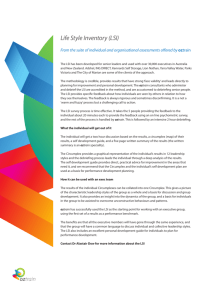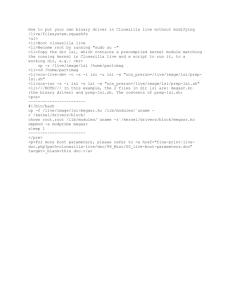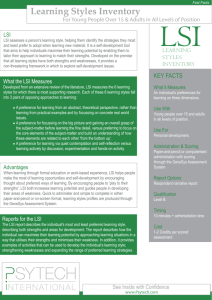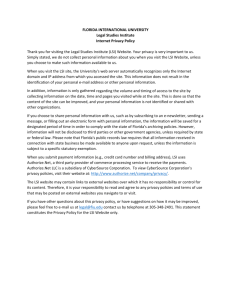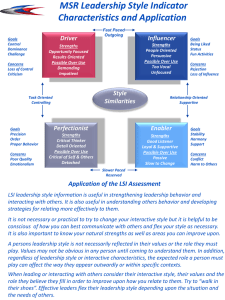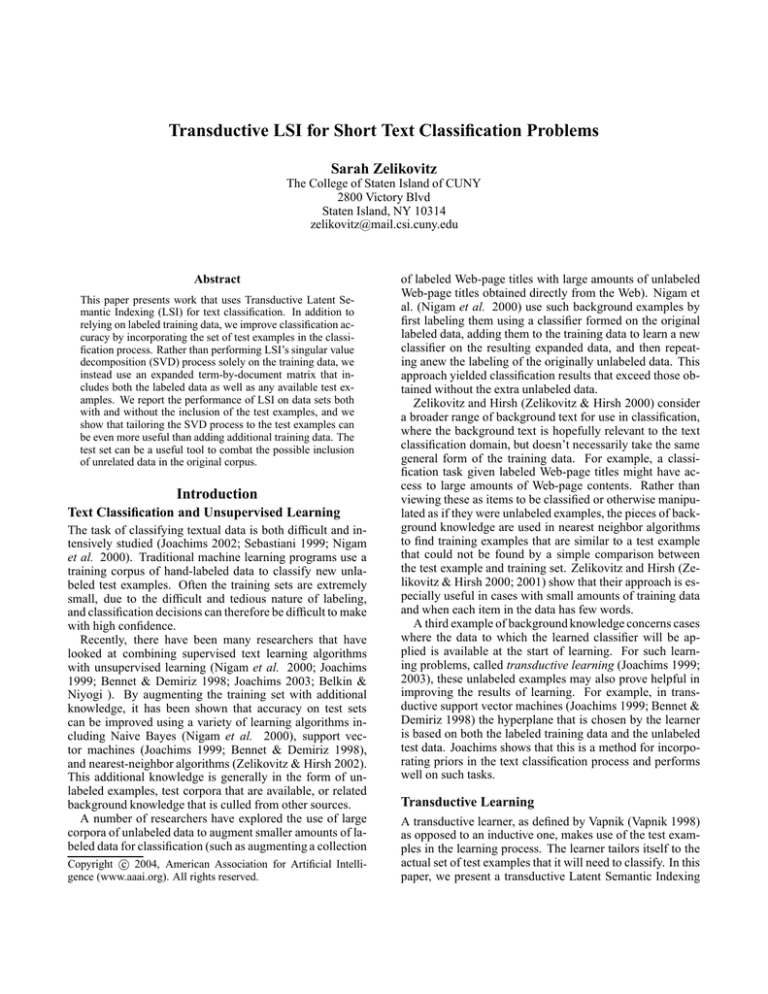
Transductive LSI for Short Text Classification Problems
Sarah Zelikovitz
The College of Staten Island of CUNY
2800 Victory Blvd
Staten Island, NY 10314
zelikovitz@mail.csi.cuny.edu
Abstract
This paper presents work that uses Transductive Latent Semantic Indexing (LSI) for text classification. In addition to
relying on labeled training data, we improve classification accuracy by incorporating the set of test examples in the classification process. Rather than performing LSI’s singular value
decomposition (SVD) process solely on the training data, we
instead use an expanded term-by-document matrix that includes both the labeled data as well as any available test examples. We report the performance of LSI on data sets both
with and without the inclusion of the test examples, and we
show that tailoring the SVD process to the test examples can
be even more useful than adding additional training data. The
test set can be a useful tool to combat the possible inclusion
of unrelated data in the original corpus.
Introduction
Text Classification and Unsupervised Learning
The task of classifying textual data is both difficult and intensively studied (Joachims 2002; Sebastiani 1999; Nigam
et al. 2000). Traditional machine learning programs use a
training corpus of hand-labeled data to classify new unlabeled test examples. Often the training sets are extremely
small, due to the difficult and tedious nature of labeling,
and classification decisions can therefore be difficult to make
with high confidence.
Recently, there have been many researchers that have
looked at combining supervised text learning algorithms
with unsupervised learning (Nigam et al. 2000; Joachims
1999; Bennet & Demiriz 1998; Joachims 2003; Belkin &
Niyogi ). By augmenting the training set with additional
knowledge, it has been shown that accuracy on test sets
can be improved using a variety of learning algorithms including Naive Bayes (Nigam et al. 2000), support vector machines (Joachims 1999; Bennet & Demiriz 1998),
and nearest-neighbor algorithms (Zelikovitz & Hirsh 2002).
This additional knowledge is generally in the form of unlabeled examples, test corpora that are available, or related
background knowledge that is culled from other sources.
A number of researchers have explored the use of large
corpora of unlabeled data to augment smaller amounts of labeled data for classification (such as augmenting a collection
c 2004, American Association for Artificial IntelliCopyright gence (www.aaai.org). All rights reserved.
of labeled Web-page titles with large amounts of unlabeled
Web-page titles obtained directly from the Web). Nigam et
al. (Nigam et al. 2000) use such background examples by
first labeling them using a classifier formed on the original
labeled data, adding them to the training data to learn a new
classifier on the resulting expanded data, and then repeating anew the labeling of the originally unlabeled data. This
approach yielded classification results that exceed those obtained without the extra unlabeled data.
Zelikovitz and Hirsh (Zelikovitz & Hirsh 2000) consider
a broader range of background text for use in classification,
where the background text is hopefully relevant to the text
classification domain, but doesn’t necessarily take the same
general form of the training data. For example, a classification task given labeled Web-page titles might have access to large amounts of Web-page contents. Rather than
viewing these as items to be classified or otherwise manipulated as if they were unlabeled examples, the pieces of background knowledge are used in nearest neighbor algorithms
to find training examples that are similar to a test example
that could not be found by a simple comparison between
the test example and training set. Zelikovitz and Hirsh (Zelikovitz & Hirsh 2000; 2001) show that their approach is especially useful in cases with small amounts of training data
and when each item in the data has few words.
A third example of background knowledge concerns cases
where the data to which the learned classifier will be applied is available at the start of learning. For such learning problems, called transductive learning (Joachims 1999;
2003), these unlabeled examples may also prove helpful in
improving the results of learning. For example, in transductive support vector machines (Joachims 1999; Bennet &
Demiriz 1998) the hyperplane that is chosen by the learner
is based on both the labeled training data and the unlabeled
test data. Joachims shows that this is a method for incorporating priors in the text classification process and performs
well on such tasks.
Transductive Learning
A transductive learner, as defined by Vapnik (Vapnik 1998)
as opposed to an inductive one, makes use of the test examples in the learning process. The learner tailors itself to the
actual set of test examples that it will need to classify. In this
paper, we present a transductive Latent Semantic Indexing
algorithm. LSI uses singular value decomposition to reexpress examples in a smaller, simpler space that hopefully reflects some semantic meanings of the space. As opposed to
using the training examples for the construction of the new
space, and ’folding’ (Deerwester et al. 1990; Dumais 1995;
Berry, Dumais, & O’Brien 1995) the test examples into the
new space, or updating the singular value decomposition,
(Berry, Dumais, & Letsche 1995) we actually use the test
examples during the singular value decomposition. In this
way the reexpression of the space of training and test examples more closely reflects the set to be tested.
In the next section we describe LSI, and show how we use
it for nearest neighbor text classification. We then present
our method for incorporating test examples with a set of
results on varied tasks as well as a discussion of why this
method is particularly useful for this type of learner and
these types of tasks.
Latent Semantic Indexing
Latent Semantic Indexing (Dumais 1995; 1993; 1996; Deerwester et al. 1990) is based upon the assumption that there
is an underlying semantic structure in textual data, and that
the relationship between terms and documents can be redescribed in this semantic structure form. Textual documents are represented as vectors in a vector space. Each position in a vector represents a term (typically a word), with
the value of a position i equal to 0 if the term does not appear in the document, and having a positive value otherwise.
Based upon previous research (Dumais 1993) we represent
the positive values as a local weight of the term in this document multiplied by a global weight of the term in the entire corpus. The local weight of a term t in a document d
is based upon the log of the total frequency of t in d. The
global weight of a term is the entropy of that term in the
corpus, and is therefore based upon the number of occurrences of this term in each document. The entropy equals
P
log(ptd )
where n is the number of documents and
1 − d ptdlog(n)
ptd equals the number of times that t occurs in d divided
by the number of total number of times that t occurs. This
formula gives higher weights to distinctive terms. Once the
weight of each term in every document is computed we can
look at the corpus as a large term-by-document (t × d) matrix X, with each position xij corresponding to the absence
or weighted presence of a term (a row i) in a document (a
column j). This matrix is typically very sparse, as most documents contain only a small percentage of the total number
of terms seen in the full collection of documents.
Unfortunately, in this very large space, many documents
that are related to each other semantically might not share
any words and thus appear very distant, and occasionally
documents that are not related to each other might share
common words and thus appear to be closer than they actually are. This is due to the nature of text, where the same
concept can be represented by many different words, and
words can have ambiguous meanings. LSI reduces this large
space to one that hopefully captures the true relationships
between documents. To do this, LSI uses the singular value
decomposition of the term by document (t × d) matrix.
The singular value decomposition (SVD) of the t × d matrix, X, is the product of three matrices: T SD T , where T
and D are the matrices of the left and right singular vectors
and S is the diagonal matrix of singular values. The diagonal
elements of S are ordered by magnitude, and therefore these
matrices can be simplified by setting the smallest k values
in S to zero.1 The columns of T and D that correspond to
the values of S that were set to zero are deleted. The new
product of these simplified three matrices is a matrix X̂ that
is an approximation of the term-by-document matrix. This
new matrix represents the original relationships as a set of
orthogonal factors. We can think of these factors as combining meanings of different terms and documents; documents
are then re-expressed using these factors.
LSI for Retrieval
When LSI is used for retrieval, a query is represented in the
same new small space in which the document collection is
represented in. This is done by multiplying the transpose of
the term vector of the query with matrices T and S −1 . Once
the query is represented this way, the distance between the
query and documents can be computed using the cosine metric, which represents a numerical similarity measurement
between documents. LSI returns the distance between the
query and all documents in the collection. Those documents
that have higher cosine distance value than some cutoff point
can be returned as relevant to the query.
LSI for Classification
We are using LSI for text classification, so we can henceforth refer to the document collection as the training examples and the query as a test example. Using the cosine similarity measure, LSI returns the nearest neighbors of a test
example in the new space, even if the test example does not
share any of the raw terms with those nearest neighbors. We
can look at the result of the LSI query as a table containing
the tuples
htrain-example, train-class, cosine-distancei
with one line in the table per document in the training collection. There are many lines in the table with the same
train-class value that must be combined to arrive at one
score for each class. We use the noisy-or operation to
combine the similarity values that are returned by LSI to
arrive at one single value per class. If the cosine values
for documents of a given classQare {s1 , . . . , sn }, the fin
nal score for that class is 1 − i=1 (1 − si ). Whichever
class has the highest score is returned as the answer to
the classification task. Based upon (Yang & Chute 1994;
Cohen & Hirsh 1998) only the thirty closest neighbors are
kept and combined. This method of nearest neighbor in conjunction with LSI we term LSI-nn.
Incorporating the Test Examples
What is most interesting to us about the singular value decomposition transformation is that it does not deal with the
1
The choice of the parameter k can be very important. Previous
work has shown that a small number of factors (100-300) often
achieves effective results.
classes of the training examples at all. This gives us an
extremely flexible learner, for which the addition of other
available data is quite easy. Since LSI is an unsupervised
learner and it simply creates a model of the domain based
upon the data that it is given, there are a number of alternative methods that we could use to enhance its power. Instead
of simply creating the term-by-document matrix from the
training examples alone, we can combine the training examples with other sources of knowledge to create a much larger
term-by-“document” matrix, Xn . One such method would
be to include the test examples in the creation of the reduced
space. If the original set of training documents is expanded
to include both the training set and the test set, and SVD
is run on this expanded matrix, hopefully semantic associations that are relevant to classifying the test instances would
be found that could not be found if the SVD was run on the
training set alone.
This type of learning is related to what is termed by Vapnik (Vapnik 1998) as “transductive learning.” Instead of simply using the training data, transduction makes use of the
test examples in choosing the hypothesis of the learner. In
the case of the nearest neighbor algorithm that we presented
above, we do not really find a hypothesis for the learner.
However, the recreation of the space with the incorporation of the test examples does choose a representation based
upon the test examples. The reduction of dimensionality of
the training/test set combined allows the smaller space to
more accurately reflect the test set to which it will be applied
for classification. The inclusion of the test examples into the
original matrix allows LSI to calculate entropy weights of
words with the vocabulary and examples and co-occurrences
of words in the test set.
In particular, when using small samples of data, the inclusion of the test set will outperform classification done by
’folding in’ the test set. In general, this is because LSI, as an
unsupervised learning algorithm will be helped by the inclusion of more data. For small samples of data, we can look at
the test set as simply a way of obtaining pieces of unlabeled
data that are guaranteed to be relevant to the task. With short
text classification tasks often there are words in a test set that
have not occurred in the training set at all.
To illustrate this, let us look at a sample piece of data
from the Electronic Zoo ( www.netvet.wustl.edu), where
the text classification task is to place a new Web page title
under the correct animal category. The test example:
Equine Protozoal Myeloencephalitis (Clara K. Fenger,
DVM, PhD, DACVIM)
which is the title of a Web page discussing diseases of
horses, is misclassified when the test set is not included in
the original singular value decomposition. To see why, two
of the nearest neighbors from the training set are:
Bayer Equine WellCare Program, horse
Bayer Advantage Flea Adulticide Page, cat
The word Bayer which occurs with the word Equine in the
first neighbor causes the second neighbor to be returned as
well. Obviously, these two training examples are close to
each other in the reduced space. When all thirty nearest
neighbors are combined, the final result that is returned is
cat, which is the incorrect class. When the test examples
are included, however, this second training example is not
returned. Instead all the nearest neighbors belong to the correct category.
Empirical Results
Data Sets
We ran this program on five different data sets that we (and
others) have used for text classification. A table showing the
name of the data set, url, number of examples, total number
of classes, and average length of examples can be seen in
Table 1.
Technical papers One common text categorization task is
assigning discipline or sub-discipline names to technical papers. We created a data-set from the physics papers archive,
where we downloaded the titles for all technical papers in
the first three areas in physics (astrophysics, condensed matter, and general relativity and quantum cosmology) for the
month of March 1999 (Zelikovitz & Hirsh 2000).
Web page titles We have taken two data sets from previous work on text classification (Cohen & Hirsh 1998;
Zelikovitz & Hirsh 2000). The first, NetVet, included the
Web page headings for its pages concerning cows, horses,
cats, dogs, rodents, birds and primates. For example, a training example in the class birds might have been: “Wild Bird
Center of Walnut Creek”.
Companies The second of these data sets consisted of a
training set of company names, 2472 in all, taken from the
Hoover Web site (http://www.hoovers.com) labeled with one
of 124 industry names.
News Another data set that we created was obtained from
Clarinet news. We downloaded all articles under the sports
and banking categories for one month, using the most recent
for training and test sets. The training/test set consisted of
the first 9 words of each article.
Thesaurus Roget’s thesaurus places all words in the English language into one of six major categories: space, matter, abstract relations, intellect, volition, and affection. From
http://www.thesaurus.com, we created a labeled training/test
set of 1000 words, sometimes including a description of the
word if the web site contained a description for disambiguation, with each word associated with one category.
Results
We ran LSI without the test examples, which we term LSInn, and LSI incorporating the test examples, which we term
LSI-test on all the data sets, using the full number of training examples as well as subsets of the training examples.
Each result reported for the Physics titles, NetVet, Business,
and Thesaurus data sets represents an average of five crossvalidated runs. For each cross-validated run, four-fifths of
the data was used as the training set and one-fifth was used
as the test set. Holding each test set steady, the number of
examples in the training sets were varied. Each of the five
data sets was tested with LSI-nn and LSI-test using 20, 40,
60, 80, and 100 percent of the training data.
Table 1: Details of the Data Sets
Size
1066
1789
2472
1033
1000
In Figures 1– 5 we present the accuracy rates for LSInn and LSI-test on five data sets. As we can see from the
numbers presented, LSI-test always outperforms LSI-nn, although often by a small amount.
An interesting observation that we can make from these
graphs is that supplementing the test examples is more useful than simply adding additional labeled examples. In the
physics data set and the business data set, for example, incorporating the test set with 40% of the data performed better
than 100% of the data without the test set. Since all these
results were 5-fold cross validated, the number of examples
in the test set is equal to 20% of the full set of data, yet the
accuracy of LSI-test at a given point is higher than LSI-nn,
at points to the right of it in the graph.
A major drawback of this method is that it assumes that
the entire corpus of test examples is available when SVD is
done, which is not always the case. In the examples that we
present, for instance, the test sets are quite small compared
to a possible set of unlabeled examples, which may be much
larger. The gains that could be made in accuracy by adding
the test set into the singular value decomposition process is
therefore limited, because the number of test examples that
are available is limited. However, it is still the case that we
can look at the test set as an external corpus of background
knowledge and use it alone, or in conjunction with other
sources of knowledge to create the new semantic space. The
test examples can be particularly useful in the LSI approach,
because since the test examples are most closely related to
the training set, we do not have to worry about modeling
an unrelated concept that appears in the background knowledge, but that does not appear in the training and test set.
The incorporation of the test set also allows the SVD process to place emphasis on terms that will be useful in the
classification process, since they appear in the test set.
Number of Classes
2
7
124
2
6
Avg Length in Words
12
5
4
9
1
100
LSI-nn
LSI-test
Accuracy
URL
xxx.lanl.gov
www.netvet.wustle.edu
www.hoovers.com
www.clarinet.com
wwww.thesaurus.com
90
80
20
40
60
80
Percent of Data
100
Figure 1: LSI with and without test examples for the two
class paper title problem
60
LSI-nn
LSI-test
Accuracy
Data Set
Physics
NetVet
Business
News
Thesaurus
50
Summary
We have presented a method for incorporating test examples
into text classification using LSI. The singular value decomposition is performed on a term-by-document matrix that includes both the training examples and test examples. This
allows test examples to be compared to the training examples in a new space that reflects patterns in the text in the
domain that may not be found when confronted solely with
training data. We have shown empirically that this increases
the accuracy rates for classification problems.
40
20
40
60
80
Percent of Data
100
Figure 2: LSI with and without test examples for the netvet
problem
30
Accuracy
30
Accuracy
LSI-nn
LSI-test
20
LSI-nn
LSI-test
20
10
20
10
20
40
60
80
Percent of Data
100
Figure 3: LSI with and without test examples for the business problem
100
Accuracy
LSI-nn
LSI-test
90
80
20
40
60
80
Percent of Data
100
Figure 4: LSI with and without test examples for the news
problem
40
60
80
Percent of Data
100
Figure 5: LSI with and without test examples for the thesaurus problem
References
Belkin, M., and Niyogi, P. Semi-supervised learning on
manifolds. Machine Learning Journal: Special Issue on
Clustering, Forthcoming.
Bennet, K., and Demiriz, A. 1998. Semi-supervised support vector machines. Advances in Neural Information Processing Systems 12:368–374.
Berry, M. W.; Dumais, S. T.; and Letsche, T. A. 1995.
Computational methods for intelligent information access.
In Proceedings of Supercomputing 95.
Berry, M.; Dumais, S.; and O’Brien, G. W. 1995. Using
linear algebra for intelligent information retrieval. SIAM
Review 37(4):573–595.
Cohen, W., and Hirsh, H. 1998. Joins that generalize:
Text categorization using WHIRL. In Proceedings of the
Fourth International Conference on Knowledge Discovery
and Data Mining, 169–173.
Deerwester, S.; Dumais, S.; Furnas, G.; and Landauer, T.
1990. Indexing by latent semantic analysis. Journal for the
American Society for Information Science 41(6):391–407.
Dumais, S. 1993. LSI meets TREC: A status report.
In Hartman, D., ed., The first Text REtrieval Conference:
NIST special publication 500-215, 105–116.
Dumais, S. 1995. Latent semantic indexing (LSI): TREC3 report. In Hartman, D., ed., The Third Text REtrieval
Conference, NIST special publication 500-225, 219–230.
Dumais, S. 1996. Combining evidence for effective information filtering. In AAAI Spring Symposium on Machine
Learning and Information Retrieval, Tech Report SS-9607.
Joachims, T. 1999. Transductive inference for text classification using support vector machines. In Proceedings of
the Sixteenth International Conference on Machine Learning, 200–209.
Joachims, T. 2002. Learning to Classify Text using Support Vector machines. Ph.D. Dissertation, University of
Dortmund.
Joachims, T. 2003. Transductive learning via spectral
graph partitioning. In Proceedings of the International
Conference on Machine Learning (ICML), 290–297.
Nigam, K.; Mccallum, A. K.; Thrun, S.; and Mitchell, T.
2000. Text classification from labeled and unlabeled documents using EM. Machine Learning 39(2/3):103–134.
Sebastiani, F. 1999. Machine learning in automated text
categorization. Technical Report IEI-B4-31-1999.
Vapnik, V. N. 1998. Statistical Learning Theory. Wiley.
Yang, Y., and Chute, C. 1994. An example-based mapping
method for text classification and retrieval. ACM Transactions on Information Systems 12(3):252–295.
Zelikovitz, S., and Hirsh, H. 2000. Improving short text
classification using unlabeled background knowledge to
assess document similarity. In Proceedings of the Seventeenth International Conference on Machine Learning,
1183–1190.
Zelikovitz, S., and Hirsh, H. 2001. Using LSI for text classification in the presence of background text. In Proceedings of the Tenth Conference for Information and Knowledge Management, 113–118.
Zelikovitz, S., and Hirsh, H. 2002. Integrating background
knowledge into nearest-Neighbor text classification. In Advances in Case-Based Reasoning, ECCBR Proceedings, 1–
5.


